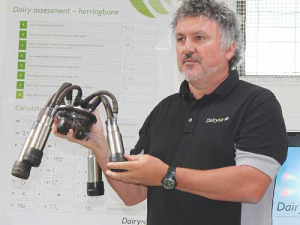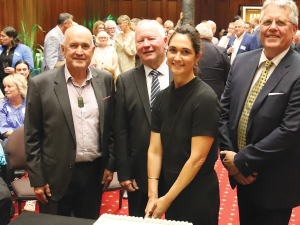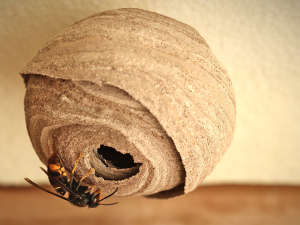Some milkers in New Zealand could be lifting 1500-1800kg during each milking, and so doing a lot of work, says Josh Wheeler, a milk quality consultant.
Our lightest cluster set-up in NZ weighs about 1.7kg, and the heaviest is close to 4kg, he told a recent Efficient Milking workshop.
So a person milking 580 cows in a rotary with a 3kg cluster is lifting about 1500-1800kg every milking, he says.
Wheeler told herringbone milkers, if someone told you to shift a tonne of urea with a 2.5kg shovel you would tell him to “get stuffed”.
“But the reality is you are probably doing that every milking. You need to think about how we are doing in respect of repetitive use syndrome… what we are doing and how we are cupping and the technique you use to make you efficient.”
There is a big time difference between a good cupping technique and a poor cupping technique, he says. In a rotary with a six-seven minute round, typically the milker has about eight seconds for the cupping procedure so should have a cupping technique of about four seconds. But a lot of our cupping techniques are about eight-nine seconds.
The hardest cup to put on is the one you have to reach for, he says.
“The first method anyone is taught is the round-the-circle method typically designed for herringbones. When you are taking the cup from one side to another you are turning your hand and grabbing the hardest cup first, attaching, then going around the circle.
“So normally you are trying to change hands as you change sides of the pit in the herringbone.
“In a herringbone, if I am on the right side of the pit I should be holding the cups in my left hand and trying to cup with my right hand because then I’m not stretching.”
In a rotary, typically you start off doing the round-the-circle method but to change hands you need to use another method.
The other way to change hands is two at a time -- trying to attach both cups at the same time, he says. This can be done in herringbones as well. Put on two front cups more or less at once, then the back right, then the back left with the other hand.
See www.dairynz.co.nz/milkingfor detail
With clusters, most of the weight is in the shell, he says. As we have changed technology we have never really designed a cluster for the milker. A milker needs something small, light and easy to handle.
Sometimes the size of the shell can make a big difference.
“You look at a lot of people milking these days: many haven’t got huge hands. One of the struggles on rotaries is the ability to hold two at a time. You will notice that when you get a shell 5mm smaller it is a lot easier to do two at a time.
“If you have a cluster that is different, for instance a 3.5kg set-up, the easiest way is to just change the shell.”
In a rotary you should match the speed of rotation to the speed of the efficient comfortable cupping technique of the cups-on person. You base your speed of rotation on that, regardless of how many cows go around twice.
The principle of milking in a herringbone is trying to get to the point at which we can open the exit gate as quickly as possible. If you have two people milking in a herringbone, you want them to work as close together as they can, so they can open the exit gate as quickly as possible.
If you are one person in a herringbone, you aim to do everything as you go.
The first thing to observe in an efficient herringbone is “as soon as cow number one is in position you should be cupping her in 30 seconds”.
“As soon as there are four cows in front of me I should start teat spraying; every minute I lose at the beginning I will never regain.”
Bunny-hopping two staff members – starting about five cows apart -- in a 40-aside is worth three minutes more, rather than one milker at cow one and one at cow 20. Three minutes per row can save 20-30 minutes per milking – or an hour over two milkings a day.
Wheeler says DairyNZ has built a module on how to work efficiently in a herringbone and in a rotary.
Experienced milkers who learn the base method know they can change it to make it faster. But they are giving farmers the tools to give staff members.


















